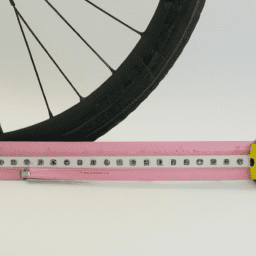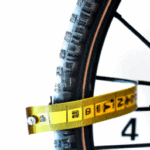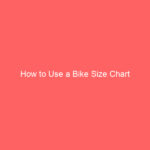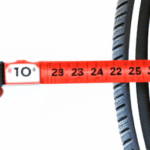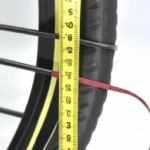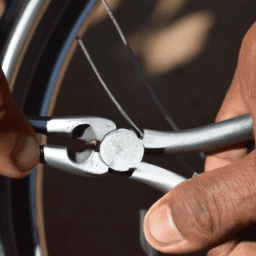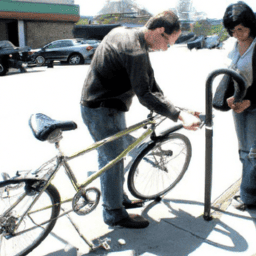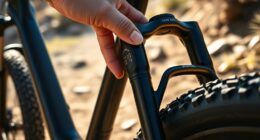For cyclists, knowing how to size your tire is crucial, akin to finding the perfect pair of shoes for yourself, but in this case, for your bicycle.
Just as you wouldn’t wear shoes that are too big or too small, you wouldn’t want to ride on tires that don’t fit your bike properly. Measuring your tire size may seem tricky at first, but with the right tools and knowledge, it’s actually quite simple.
Think of your bike’s tires like the foundation of a building. Without a solid foundation, the structure won’t stand up properly. Similarly, if your bike’s tires are too big or too small, it can affect your ride, making it uncomfortable or even dangerous.
That’s why it’s important to measure your tire size accurately so you can choose the right replacement tires or make sure the ones you have are the right fit. In this article, I’ll walk you through the steps to measure your bike’s tire size like a pro.
Key Takeaways
- Measuring bike tire size involves determining the bead seat diameter (BSD) and width, which are printed on the sidewall of the tire.
- Accurate measurement of tire size is crucial for purchasing replacement tires and ensuring a comfortable and safe ride.
- Different tire tread patterns affect bike handling, and choosing the appropriate tire size involves matching to rim size and considering riding style and conditions.
- Proper tire inflation is important for accurate measurement, and converting measurements from metric to imperial or vice versa can be tricky.
Understanding the Parts of a Tire
Let’s take a closer look at the various components that make up a tire, so you can better understand how to measure your bicycle tire size. Understanding tire construction is a fundamental aspect of measuring tire size.
A tire is composed of the tread, sidewall, bead, and casing. The tread is the outermost layer of the tire that comes into contact with the ground. Different types of tire treads are designed for specific purposes such as road cycling, mountain biking, or commuting.
The sidewall is the vertical part of the tire that connects the tread to the bead. The bead is the part of the tire that fits onto the rim and keeps the tire in place. The casing is the structure that enables the tire to retain its shape and provides support to the tread.
To measure your tire size, you will need to know the dimensions of your tire’s bead seat diameter, or BSD. BSD is the diameter of the tire bead seat, which is the part of the tire that fits onto the rim. BSD is typically measured in millimeters and can be found printed on the sidewall of the tire.
Once you have determined the BSD, you can then measure the width of the tire. Tire width is also measured in millimeters and can be found printed on the sidewall of the tire. With these two measurements, you can accurately determine the size of your bicycle tire.
Units of Measurement
You can easily identify the dimensions of your bike’s rubber by checking the markings on the sidewall. The tire size is typically expressed as a combination of numbers and letters. The numbers represent the tire’s width, diameter, and aspect ratio, while the letters indicate the type of tire and the load capacity.
When it comes to measuring tire size, there are two units of measurement: metric and imperial. Here are some things to keep in mind:
- Metric units are expressed in millimeters, centimeters, and meters, while imperial units use inches.
- Metric measurements are more precise than imperial measurements.
- Converting measurements from one system to another can be a bit tricky, so it’s important to use a reliable conversion chart or calculator.
Knowing the units of measurement is important when it comes to understanding the dimensions of your bike’s rubber. In the next section, we’ll discuss the tools you’ll need to measure your bike tire accurately.
Tools You Will Need
One essential aspect of determining the dimensions of your bike’s rubber is having the appropriate tools readily available. These tools include a ruler or tape measure, a caliper, and a tire gauge. The measuring accuracy of the tools should be checked before using them to avoid any mistakes in determining the tire size.
Common mistakes that people make when measuring their bike tire size include not measuring the correct part of the tire, not taking into account the width of the rim, and not converting the measurement correctly from metric units to inches or vice versa. To avoid these mistakes, it’s important to use the appropriate tools and to follow the correct procedure for measuring the tire size.
With the right tools and accurate measurement, you can confidently determine the size of your bike tire and ensure that you purchase the appropriate replacement tire.
How to Measure Your Tire
To accurately determine your bike tire size, you need to measure the diameter, width, and aspect ratio.
First, measure the diameter by finding the distance between the two edges of the tire’s inner rim.
Next, measure the width by finding the distance between the two edges of the tire’s tread.
Finally, calculate the aspect ratio by dividing the tire’s height by its width.
These measurements are crucial in finding the right replacement tire or tube for your bike.
Determining the Diameter
Measuring the diameter of a bicycle tire is like finding the heart of the wheel. It’s the central measurement that determines the size of the tire, and it’s essential to get it right.
To determine the diameter, you need to measure the distance across the tire from one side to the other through the center. It’s essential to measure the diameter accurately because it will determine the fit of the tire and ensure that it’s compatible with your bicycle.
Calculating the circumference of the tire is the first step in determining the diameter. You can do this by using a tape measure or a string to measure the distance around the tire at its widest point. You’ll then need to convert this measurement from metric to imperial if necessary.
Once you have the circumference, you can divide it by pi (3.14) to get the diameter. Now that you know the diameter, you can move on to measuring the width of the tire to ensure you get the right fit for your bicycle.
Measuring the Width
Determining the appropriate fit for your bike’s wheel involves accurately gauging the tire’s width. One way to determine its width is by measuring the circumference of the tire. To do this, wrap a tape measure around the widest part of the tire and record the measurement.
Keep in mind that the width of the tire should be compared to the width of the rim to ensure a proper fit. It’s important to consider the relationship between the tire and the rim when measuring the width of the tire. A tire that is too narrow or too wide for the rim can cause problems with stability and handling.
Comparing the width of the tire to the width of the rim can help ensure that the tire is an appropriate fit. Once you’ve determined the width of the tire and the diameter of the wheel, the next step is to calculate the aspect ratio.
Calculating the Aspect Ratio
Now that you have the width of your bike’s tire and the diameter of the wheel, it’s time to calculate the aspect ratio, which will help you choose the appropriate tire height for your ride. The aspect ratio is the height of the tire sidewall expressed as a percentage of the tire’s width. To calculate it, simply divide the height by the width and multiply by 100. For example, if the tire width is 25mm and the sidewall height is 12.5mm, the aspect ratio is 50%.
Comparing aspect ratios is important because it affects the ride quality of your bike. A higher aspect ratio means a taller tire sidewall, which can provide more cushioning and better grip on rough roads, but it can also increase rolling resistance and decrease overall speed. Factors affecting aspect ratio include the type of riding you’ll be doing, the condition of the roads you’ll be riding on, and personal preference. Keep these in mind when selecting the appropriate tire for your bike. Choosing the right size tire involves more than just calculating the aspect ratio, so let’s dive into the next section to learn more.
Choosing the Right Size Tire
When choosing the right size tire for my bicycle, I must consider various factors.
First, I need to match the tire size to the rim size, which is crucial to ensure a secure fit and prevent any accidents on the road.
Additionally, I must also consider my riding style and the conditions I will encounter, as these factors can impact the tire’s performance and durability.
Overall, selecting the appropriate tire size is an essential step in maintaining a safe and enjoyable cycling experience.
Matching Tire Size to Rim Size
Matching your tire size to the correct rim size is crucial for a smooth and safe ride on your bike. To ensure proper matching, you must know the tire size and the rim size of your bike.
Here are a few tips to help you match your tire size to the rim size:
-
Check the tire pressure: Before matching your tire size to the rim size, make sure that the tire is properly inflated. Proper inflation will help you get accurate results.
-
Look at the tread patterns: Different tires have different tread patterns, and these patterns can affect the way your bike handles. Make sure to choose a tire with a tread pattern that matches your riding style and conditions.
-
Measure the tire: You can measure the tire size by looking at the sidewall. The size is usually printed there, and it will include the width, height, and diameter of the tire.
-
Check the rim: The rim size is usually printed on the rim itself. Make sure to match the tire size to the rim size to ensure a smooth and safe ride.
Now that you know how to match your tire size to the rim size, the next step is to consider your riding style and conditions.
Considering Riding Style and Conditions
To ensure a smooth and safe ride, it’s important to take into account your riding style and the conditions you’ll be riding in. If you’re planning to ride on mountain trails, you’ll want to choose wider tires with more aggressive treads to handle the rough terrain.
On the other hand, if you’re a road cyclist, you’ll want narrower tires with smoother treads to reduce rolling resistance and increase speed. In addition to your riding style, it’s also important to consider the conditions you’ll be riding in.
Wet conditions require tires with better grip, so look for tires with deeper treads and a softer rubber compound. In dry conditions, however, you’ll want tires with less rolling resistance, so opt for tires with a harder rubber compound and a smoother tread pattern.
By taking into account these factors, you can choose the right tire size for your bike and ensure a comfortable and safe ride.
Frequently Asked Questions
Can I use any size tire on my bicycle or do I need to match the size exactly?
It’s important to match tire size when replacing or upgrading your bicycle tires. While some compatibility with different sizes exists, it’s best to stick to the recommended size for optimal performance and safety.
What is the difference between a tire’s width and its diameter?
When considering performance, both tire width and diameter are important factors. Tire width affects grip, while diameter affects how easily you can roll over obstacles. The overall tire size also affects the handling and stability of your bike.
How does tire pressure affect the size of my tire?
Oh, the joys of tire pressure. Not only does it affect the ride, but it also affects the size of my tire. The effects of inflation pressure can throw off measuring accuracy, so it’s important to keep it consistent.
Are there any safety concerns I should be aware of when measuring my tire size?
When measuring my bike tire size, it’s important to ensure measuring accuracy and use proper tools. Safety concerns include avoiding sharp objects and maintaining a stable bike position.
Can I measure my tire size without removing the tire from the wheel?
Yes, I can measure my tire size without removing it from the wheel. Non invasive methods like visual inspection can be used to determine the dimensions. Using a tape measure, I can measure the diameter and width accurately.
Conclusion
Well, that’s how you measure a bicycle tire size. It may seem daunting, but with the right tools and a bit of patience, you can get it done in no time.
Remember to take note of the units of measurement and familiarize yourself with the different parts of a tire before proceeding. Double-check your measurements to ensure accuracy and avoid mishaps.
In conclusion, measuring a bicycle tire size is an essential skill for any cyclist. It allows you to choose the right size tire, which can improve your bike’s performance and ensure your safety on the road.
So, grab your tools and get measuring! As they say, "measure twice, cut once"and enjoy a smooth and comfortable ride on your perfectly fitting bicycle tire.
